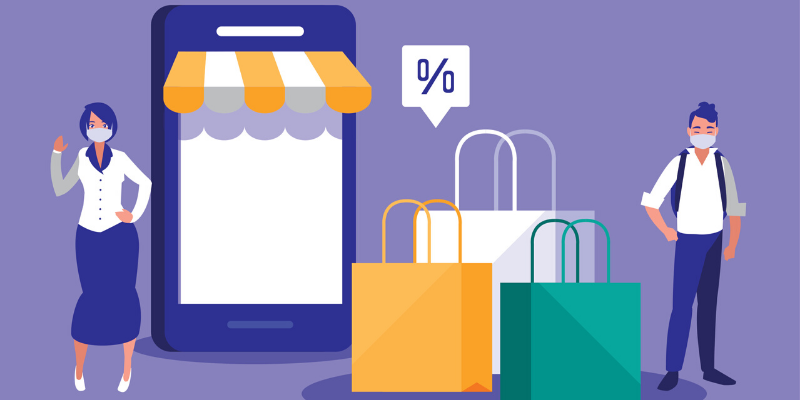
India’s ecommerce market is expected to hit $111 billion by 2024, and this number will almost double by 2026, says a report by IBEF. This rapid growth is led by increased digital penetration, changing consumer preferences, technological advancements, and innovations.
A decade ago, Indian shoppers were hesitant to buy online, but now India has gained 125 million online shoppers in the past three years and the number is rapidly growing. This growth is not just prevalent in the metro cities, but Tier II and Tier III cities have also seen rapid developments in terms of online shopping.
Today’s shoppers have evolved and they consider multiple factors like product reviews, features, etc., before making the final purchase. To ensure the shopper’s experience is enhanced and seamless, the ecommerce industry is evolving rapidly and bringing new trends.
With the changing ecosystem, consumers are looking for more personalised and innovative approaches while shopping online. Therefore, brands need to stay on top of these trends and leverage them to provide a memorable user experience.
Trends changing the ecommerce industry
1. Artificial Intelligence: Creating new-gen shopping experience
Artificial Intelligence (AI) is set to take the shopping experience through a topsy-turvy journey with endless opportunities, convenience, and efficiency. AI, machine learning, and data will play a pivotal role in the future of ecommerce to empower brands to stay ahead of the curve. From Chatbots and voice searches to creating personalised recommendations, AI is transforming the way brands engage with users.
Using the power of AI, ecommerce brands can understand what their customers want. With the help of AI, brands can curate personalised experiences based on the customer’s needs, sentiments, desires, and expectations. These insights enhance the user’s shopping experience and make them return for more.
An example of AI is the maximised use of voice search tools like Alexa, which eases the shopping experience with just a few voice commands.
2. Social Commerce: Beyond the scrolling
Social commerce is the new buzzword that has captured a lot of attention in a short span of time, thanks to the pandemic. Apart from the traditional ecommerce setup, this new way to market products online has changed the way users shop. Now, instead of window-shopping, shoppers can enjoy the scroll-shopping experience.
The market size of social commerce has grown rapidly since 2020 and it is expected to grow at a CAGR of 50-60% in the next five years, says a report.
And this number shouldn’t come as a surprise, as digital penetration has increased the number of users on social media, hence the growing demand. The estimated number of active social media users was around 467.0 million in January 2023, equating to 32.8% of the total population.
Not just the metro cities, but users from the Tier II and Tier III cities are also evolving and moving towards social commerce. Product categories like beauty, personal care, and fashion have been early adopters, but eventually other categories are also exploring these new channels. The newly-emerged and less-talked category that has captured the attention is women’s hygiene and grooming products.
The biggest advantage of social commerce platforms has been their short videos and user-generated content, which helps build a strong connection with the users. It further helps to speed up the process from inspiration to purchase. Furthermore, this provides an opportunity for new categories to generate demand among their targeted users by spreading awareness and clearing their doubts in the form of content.
3. Augmented Reality: Back to the future
Technology is indeed changing the way we shop and Augmented Reality or Virtual Reality has taken it to an entirely new dimension (literally!) Augmented reality has enabled brands to bring the offline experience inside the home of their users.
Brands like Nykaa, IKEA, and Amazon have started providing virtual reality experience for customers to get an interactive experience. For example, with Amazon, customers can place their favourite furniture in their room to create a better picture in their head of how it will look.
According to Deloitte’s global state of consumer tracker, 73% of consumers are ready to spend more on convenience. By leveraging augmented reality, brands can create a reliable and convenient experience for their users to enjoy shopping while relaxing on their couches.
4. Hyperlocal Delivery & Quick Commerce: Express shopping experience
Swift delivery in less than an hour started during the pandemic, and today this has become a potential way for local businesses to cater to their users in an organised way.
Quick commerce pioneers like Dunzo, Zepto, and Instamart have eased the daily shopping experience of users. Today’s customer wants value as well as convenience and quick commerce is helping to bridge this gap with their last-mile connectively.
The ecommerce industry is evolving rapidly and these trends are here to change the face of the traditional shopping experience. Leverage these trends to make online shopping convenient, interactive, and personalised for the shoppers and match the steps of the evolving ecommerce ecosystem in 2023 and beyond.
(Amit Relan is the Co-founder and CEO of mFilterIt, an end-to-end, one-stop shop for Ad Fraud Detection and Prevention)
Edited by Megha Reddy
(Disclaimer: The views and opinions expressed in this article are those of the author and do not necessarily reflect the views of YourStory.)










![Read more about the article [Tech50] How this Hyderabad-based startup aims to touch over 1.5 lakh Indian villages with its ‘phygital’ network](https://blog.digitalsevaa.com/wp-content/uploads/2021/12/offsite-1639375314539-300x150.png)